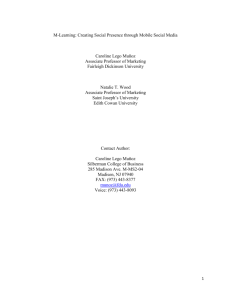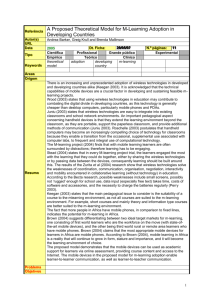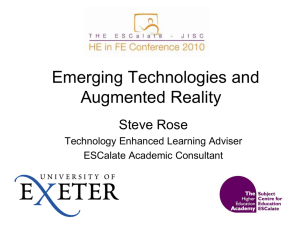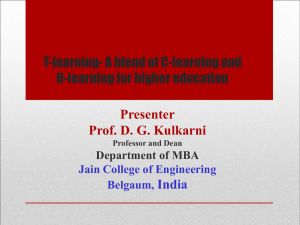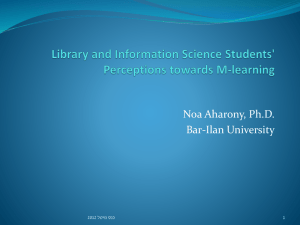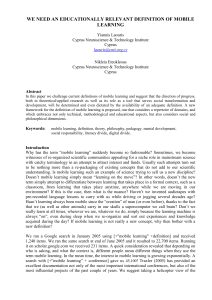M-Learning System Implementation and Features
advertisement
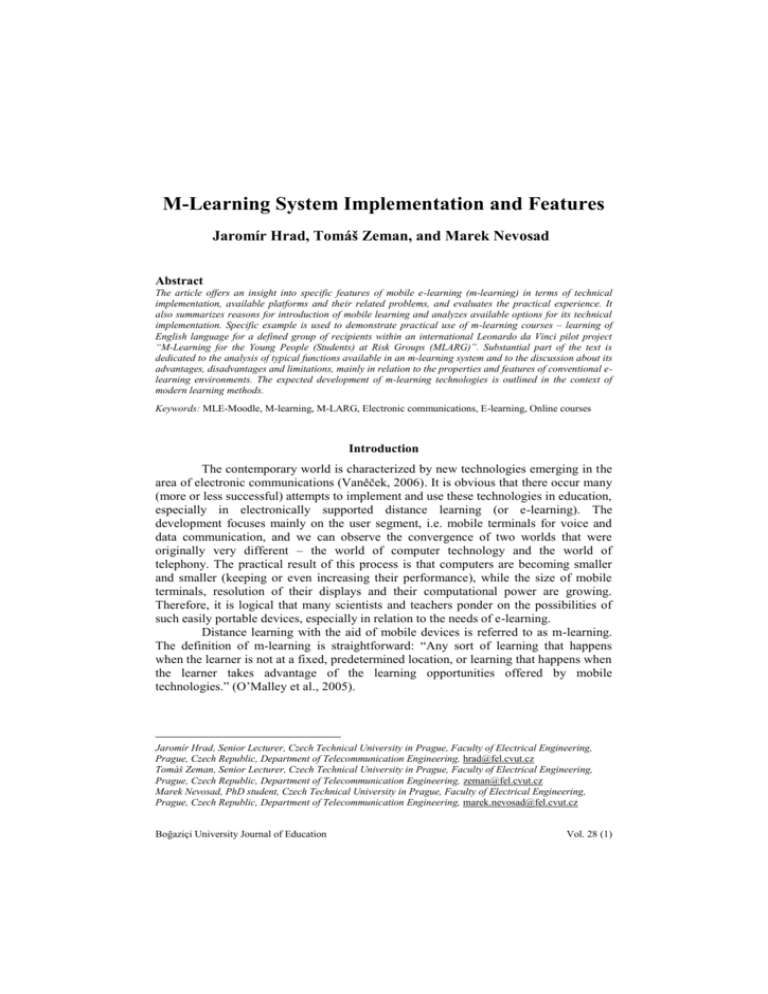
M-Learning System Implementation and Features Jaromír Hrad, Tomáš Zeman, and Marek Nevosad1 Abstract The article offers an insight into specific features of mobile e-learning (m-learning) in terms of technical implementation, available platforms and their related problems, and evaluates the practical experience. It also summarizes reasons for introduction of mobile learning and analyzes available options for its technical implementation. Specific example is used to demonstrate practical use of m-learning courses – learning of English language for a defined group of recipients within an international Leonardo da Vinci pilot project “M-Learning for the Young People (Students) at Risk Groups (MLARG)”. Substantial part of the text is dedicated to the analysis of typical functions available in an m-learning system and to the discussion about its advantages, disadvantages and limitations, mainly in relation to the properties and features of conventional elearning environments. The expected development of m-learning technologies is outlined in the context of modern learning methods. Keywords: MLE-Moodle, M-learning, M-LARG, Electronic communications, E-learning, Online courses Introduction The contemporary world is characterized by new technologies emerging in the area of electronic communications (Vaněček, 2006). It is obvious that there occur many (more or less successful) attempts to implement and use these technologies in education, especially in electronically supported distance learning (or e-learning). The development focuses mainly on the user segment, i.e. mobile terminals for voice and data communication, and we can observe the convergence of two worlds that were originally very different – the world of computer technology and the world of telephony. The practical result of this process is that computers are becoming smaller and smaller (keeping or even increasing their performance), while the size of mobile terminals, resolution of their displays and their computational power are growing. Therefore, it is logical that many scientists and teachers ponder on the possibilities of such easily portable devices, especially in relation to the needs of e-learning. Distance learning with the aid of mobile devices is referred to as m-learning. The definition of m-learning is straightforward: “Any sort of learning that happens when the learner is not at a fixed, predetermined location, or learning that happens when the learner takes advantage of the learning opportunities offered by mobile technologies.” (O’Malley et al., 2005). Jaromír Hrad, Senior Lecturer, Czech Technical University in Prague, Faculty of Electrical Engineering, Prague, Czech Republic, Department of Telecommunication Engineering, hrad@fel.cvut.cz Tomáš Zeman, Senior Lecturer, Czech Technical University in Prague, Faculty of Electrical Engineering, Prague, Czech Republic, Department of Telecommunication Engineering, zeman@fel.cvut.cz Marek Nevosad, PhD student, Czech Technical University in Prague, Faculty of Electrical Engineering, Prague, Czech Republic, Department of Telecommunication Engineering, marek.nevosad@fel.cvut.cz Boğaziçi University Journal of Education Vol. 28 (1) 64 Jaromír Hrad, Tomáš Zeman and Marek Nevosad MLARG Project Our department has been involved in research and practical application of innovative pedagogical methods for many years, and therefore we eagerly accepted the offer to participate in a European lifelong learning / Leonardo da Vinci project “MLearning for the Young People (Students) at Risk Groups (MLARG)”, coordinated by Boğaziçi University (Istanbul, Turkey), with partners in Italy, Slovakia and Czech Republic. The aim of the project is to use mobile learning technologies to design language (English) teaching materials and methodology for young people (ages 16–17) with limited financial resources studying at vocational high schools. The main reasons for choosing mobile learning are the following: m-learning helps learners to develop positive attitudes towards literacy both in school subjects and technology, m-learning motivates learners to take part in activities in mobile medium of communication via multimedia tools, such as, mediaBoard, portal page, and clips, m-learning allows “anywhere”, “anytime” and “personalized” learning for everyone, with just very basic equipment. During the implementation period of the project (2009–2011), the pilot trainees got access to m-learning facilities; it is considered that using m-learning at “anytime and anyplace” should give young people at risk groups a strong feeling of being taken care of, valued, and included in the society. M-learning should also allow them to personalize their way of learning and increase their self-esteem and self-confidence. There is a need to adapt mobile devices to education and enhance learning environments. In the project, these remarks are outlined by taking into consideration the needs of young people/students at risk groups. Different mobile platforms were tested with respect to their specific features in order to find the particular device type that would accommodate the given needs and could be used for pilot testing with a sample group of students. Such a device must be relatively inexpensive (i.e. affordable to the target group), but it should offer Internet browsing capabilities, as described above. Another goal was to identify the elements of the educational content that might be used for mobile learning without any technological or economical limitations (for example, we have to take into consideration the size and resolution of a display, but also the limited data throughput achievable with specific mobile data technologies, or the total volume of data that can be transmitted by a specific mobile user with a specific tariff plan within a given period of time). From a pedagogical and didactical viewpoint, the inclusion of mobile technologies is a new feature. Therefore it is necessary to design the technical implementation together with suitable procedures and methods that would make use of specific properties of such solution; on the other hand, any procedures in which the use of mobile terminals would bring more difficulties than benefits (compared to traditional e-learning) should be limited or even eliminated. Boğaziçi University Journal of Education Vol. 28 (1) Subsystem for M/E-learning and Virtual Training based on IMS NGN Architecture 65 Available Client Platforms In principle, the application of m-learning can be based on either of the following technologies: Java application, Web browser. Java application is a piece of software that is installed in a mobile terminal. The learning process uses off-line approach and the method does not support full range of interactive elements. There is only limited communication with a server, and only the most important data is transmitted (usually in small batches), e.g. the answers to test questions. The principle of the “web browser” approach consists in traditional serverbased solution. The complete learning system (specific type of LMS) is installed on a remote computer. Trainees access the services provided by the remote computer through a standard web browser installed in their mobile terminal device. The latter (web browser) offers more advantageous, flexible and universal solution. The advantage is that the look and/or content of the pages can be easily altered (on the server side) and there is no need to update the local software in the remote terminal (unlike the Java application). It should be also noted that the web pages work without limitations on different types of terminals (at present time, for example, it is relatively complicated to use Java applications on iPhone platform, and different versions of Java introduce various unexpected problems as well). The disadvantage is that the user interface may be slightly different for different types of browsers (similarly to non-mobile terminals). It may be also considered a specific disadvantage that this approach requires on-line data connection with higher volume of transmitted data (compared to the solution employing Java application). Although caching in the memory of a mobile browser is possible, it is still necessary to transmit more data than the current operation requires. From the viewpoint of logic, the browsing through the learning content is entirely controlled by a server. For example, when confirmation of a correct response in a test is transmitted towards a user, other content is always transmitted as well, e.g. change of a button pointing to the next question. In that case, the browser’s cache (in the mobile device) is used only for (e.g.) images or other related files (such as definitions of cascade styles). Implementation The selected technical implementation requires a LMS system installed on the server side, having the support for mobile devices already built-in, or employment of other learning system that allows such option to be supplemented. For the purposes of the MLARG project we have chosen Moodle as the learning management system. There were several reasons for this choice: we know the capabilities of Moodle LMS, its wide use, openness, favorable licensing conditions and an existing (and modifiable) support for displaying of content on mobile terminals. The purpose was to Boğaziçi University Journal of Education Vol. 28 (1) Jaromír Hrad, Tomáš Zeman and Marek Nevosad 66 preserve (to the largest possible extent) the option to study the learning content in the same GUI that is used on standard computers. It is vital for the success of m-learning implementation to provide the users of the courses with a comfortable and friendly GUI. The original Moodle system is not suitable for devices with small displays. Therefore, we have decided to use the MLE (Mobile Learning Engine) plug-in, which helps to optimize the learning content for presentation on mobile devices, organizing it into the format of relatively narrow columns. As the recent version of MLE did not meet all requirements given by the nature of the considered courses with respect to the proper presentation of their content, we have started adequate modifications of the MLE source code, so that it becomes more compatible with project objectives. In some details it was necessary to modify Moodle itself. The implementation of the mobile solution is based on key project objectives: a) b) Motivation of students to learn through presentation of the learning content in an attractive form; The given topic, i.e. English language for professional schools in tourist industry. Pilot Course We have prepared an operable version of six exemplary courses. They are relatively short and their main purpose is to verify specific functions of MLE-Moodle as well as the m-learning methodology. The courses can be accessed at http://mlarg.cvut.cz/mobile (version optimized for mobile terminals) or http://mlarg.cvut.cz/moodle (PC-compatible version for reference purposes). The following topics of the courses are currently available: Restaurant, Tourist information office, Check-in, At the travel agency, Destinations, On the tour. The target group involved in the pilot testing is composed of students at secondary schools specialized in tourist industry, and the particular objective is learning of English language with emphasis on specific situations and the corresponding vocabulary. Platform-related Issues As for the communication among students (and their teachers), usual tools common for Moodle system (chat, discussion forums, and direct messages) are available. Boğaziçi University Journal of Education Vol. 28 (1) Subsystem for M/E-learning and Virtual Training based on IMS NGN Architecture 67 We have encountered some problems related to presentation of multimedia content, caused by the wide variety of operating systems used for mobile terminals and to the different level of (different) web browsers integration. For example, Android 2.2 operating system (Samsung Galaxy i9000 S) cannot play MP3 content delivered from Moodle server directly – such file must be first saved to the memory of the phone, and then opened by the associated application. On the contrary, in Symbian OS version 9.3 (Nokia E72) or 9.2 (Nokia E66) a link to such file works correctly – but only in the integrated web browser; the attempt to use Opera Mobile 10.1 (for Nokia E72) for direct opening of multimedia files was unsuccessful and, moreover, direct link to the MP3 file did not help in this case. Windows Mobile 6.5 (HTC TouchPro 2) with Opera Mobile 9.7 browser did not have any problems and the link was working properly. In Android operating system, the described problem is caused by passing of the file to the web browser. The workaround in this case is to use a direct link to the MP3 file, outside the course (an then it is interpreted correctly), or to set file downloading in Moodle so that the browser is sent data content respecting the specific features of these browsers and devices. The initial page allows the users to download Java MLE application. However, we consider this option to be just an alternative one, as the identical operation on different types of mobile terminals cannot be guaranteed. Moreover, the Java application also has occasional problems with access to multimedia content. Implemented Functions After login and entering the homepage of the courses, the system displays a screen containing the list of available courses and the upper navigation bar (see Figure 1). The user interface and its functions are based on standard Moodle version, but some features are not available. Figure 1. Initial page Boğaziçi University Journal of Education Vol. 28 (1) 68 Jaromír Hrad, Tomáš Zeman and Marek Nevosad The overview of specific types of exercises can be seen in Figure 2. The type “Listening for gist” consists of listening to an audio file, after which the students pass a simple test (e.g. single-choice out of three options) verifying whether they have understood the meaning of the message. The “Listening for specific information” is a similar type of exercise, verifying whether the listeners understand also particular details of the message. In these tests students are usually given two attempts, and if both answers are wrong, then the correct response is eventually displayed. Figure 2. List of exercises (various types) The exercises of “Reading for gist” type focus on the understanding of written texts. The question is in the textual form, and students are offered only one attempt to answer. “Reading for specific information”, similarly, focuses on searching of specific information in a text. Individual questions are displayed successively, and a wrong answer cannot be corrected. The total numbers of correct and wrong answers are summarized at the end. The “Vocabulary” exercises (see Figure 3) are, as we could expect, intended to practice the vocabulary. The individual tasks involve completing sentences (choosing one option from a limited offer of expressions) and assigning corresponding words to pictures. Boğaziçi University Journal of Education Vol. 28 (1) Subsystem for M/E-learning and Virtual Training based on IMS NGN Architecture 69 Figure 3. Specific type of exercise (“Vocabulary”) One of the major problems is displaying and viewing of large images. As the display area is limited, there are basically two solutions coming into consideration: Displaying of the entire image in a reduced size (which introduces the risk of poor readability because of the small dimensions), or Viewing by parts, changing the displayed area with the help of horizontal and vertical scrollbars (which might be difficult to get oriented in). MLE-Moodle uses the latter option (scrollbars), as illustrated in Figure 4. The picture is displayed in its original size, but users have to move over it. However, modern devices with multi-touch screens make resizing and moving very easy. The last frequently used type of exercise is “Language use” – practicing of understanding the language. Different types of questions are available for testing. This type of exercise is included at the end of every module or lesson. Boğaziçi University Journal of Education Vol. 28 (1) 70 Jaromír Hrad, Tomáš Zeman and Marek Nevosad Figure 4. Displaying of a large picture The developed learning content includes also videos (see Figure 5). A specially prepared video server was implemented within the system. Video sequences are uploaded to the sever and then automatically converted to a format suitable for mobile devices (we have chosen MPEG-4). With respect to the limitations of other supporting technologies (such as Adobe Flash) we have decided to use displaying through HTML5 standard; however, this solution introduces a demand for an advanced web browser installed in a mobile terminal. Video can be played back directly from the displayed web page, but often there is implemented a proprietary solution for video playback in a mobile device. When a request for video playback is indicated, the integrated playback method is used (e.g. pre-installed Real Player). In this sense we can encounter similar problems as with playback of external audio files. Also, incompatibility of (usually user-installed) web browsers and integrated media players (for audio and/or video content) may occur. Boğaziçi University Journal of Education Vol. 28 (1) Subsystem for M/E-learning and Virtual Training based on IMS NGN Architecture 71 Figure 5. Video playback Two different types of learning activities were the most frequent ones in the course of MLARG learning content development – Lesson and Quiz. It was necessary to choose the type of an activity also with respect to the required feedback (Figurea 67). Boğaziçi University Journal of Education Vol. 28 (1) 72 Jaromír Hrad, Tomáš Zeman and Marek Nevosad Figure 6. Feedback after the first attempt Figure 7. Feedback after the second attempt The Lesson type was employed mainly for tasks with multiple attempts, with different feedback for each single attempt. Conclusions The completed pilot run of the courses should bring the answer to the basic question: Is m-learning a suitable complement to the electronic form of education, or is it just a modish matter to be overcome and then abandoned? (Vaněček, 2006). Therefore, the feedback obtained from the course participants and their willingness to Boğaziçi University Journal of Education Vol. 28 (1) Subsystem for M/E-learning and Virtual Training based on IMS NGN Architecture 73 use the individual learning objects on a regular basis (if any, to what extent) is crucial for the future employment of this technology in regular education. We can envisage that the m-learning technologies will become useful mainly in those areas where the learning content can be presented in a visually simplified form (with emphasis on reduced volume of textual information). Typical examples of applications include various drill learning methods (vocabulary, phrases, filling of correct words to sentences, applications supported by instructions spoken from a mobile device, single-choice from several options, etc.). On the other hand, we expect lower interest in m-learning applications that require reading of many texts, filling of numerous forms or frequent movements on the screen of a mobile terminal device, such as solving of complicated tasks, assignments requiring schemes, diagrams, graphs or videos, tasks for which the users need to compile context-based information from different resources. References O’Malley, C., Vavoula, G., Glew, J. P., Taylor, J., Sharples, M., Lefrere, P., Lonsdale, P., Naismith, L. & Waycott, J. (2005). Guidelines for Learning/Teaching/Tutoring in a Mobile Environment, MOBIlearn Project Report. Vaněček, D. (2006). Progressive Education Methods. New trends in engineering pedagogy. Workshop of the International Society of Engineering Education IGIP. Praha. ČVUT. ISBN 80-01-03459-3. Web portal of MLARG project [online]: http://mlarg.boun.edu.tr/ Acknowledgment This article has originated thanks to the grant support obtained from the EC within Leonardo da Vinci project No. 2009-TR1-LEO05-08674 – M-Learning for the Young People (Students) at Risk Groups (MLARG). Boğaziçi University Journal of Education Vol. 28 (1)


